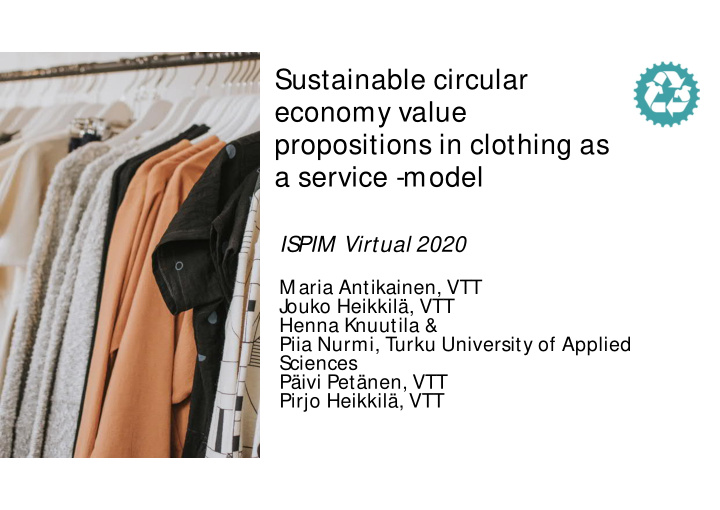



Sustainable circular economy value propositions in clothing as a service -model IS PIM Virtual 2020 Maria Antikainen, VTT Jouko Heikkilä, VTT Henna Knuutila & Piia Nurmi, Turku University of Applied Sciences Päivi Petänen, VTT Pirjo Heikkilä, VTT
T extile industry 1. The most pollutants releasing industries of the world. 2. Currently, the dominant operating logics of fashion businesses are based on the linear take-make-disposal model, the mass production and wasteful fast fashion (Pulse of the Fashion Industry, 2017). 3. Approximately, only around 20 per cent of clothing is currently reused or recycled (Global Footprint Network, 2017). It is estimated that globally customers discard annually up to USD 460 billion by throwing away of usable clothing.
Aim & Outcome What kind of value propositions clothing as a service business models offer for a) consumers, b) environment, c) society, d) other key stakeholders. The customer value proposition framework for the textile industry including sacrifices/costs and including environment, society and other central stakeholders. Antikainen et al., ISPIM Virtual 2020, June 7-10
From value proposition towards sustainable value proposition A value proposition is a statement We define sustainable value which identifies clear, measurable proposition: “as a promise on the and demonstrable benefits for economic, environmental and social consumers when purchasing a benefits that a firm's offering particular product or using service. It delivers to customer, stakeholders, should convince consumers that this and the whole society, considering product or service is superior to both the short-term and long-term other existing available alternatives impacts” of solutions on the market (e.g. (e.g., Anderson et al., 2006; Ballantyne et Rintamäki et al., 2017). al., 2011; Hart & Milstein, 2003; Hassan
Customer value Benefits Sacrifices Strategic Practical Monetary (price, cost of use, maintenance etc.) Economic Non-monetary (effort, perceived risk, time) Personal/ emotional Social (modified from Zeithaml 1998; Woodall 2003)
Research Methods • 3 Finnish clothing companies • Case study • Data triangulation • A joint workshop, April 2020 • A follow-up workshop, May 2020 • Several discussions and meeting memos as a secondary material • Related to T elaketju2 research project, funded by Business Finland and companies Antikainen et al., IS PIM Virtual 2020, J une 7-10
Environmental value Societal value Customer value +“ The content of the +“CaaSgenerates demand +“ Our business creates a modern closet is in more efficient and respect for sustainable community in the city, get-togethers and use in the rental model.” vintage pieces, fashion gatherings.” brands and lifestyle in +“Customers can -“CaaS model takes a share of the general. Demand for textile experience shopping with traditional fashion business in terms of maintenance is also clear conscience.” cash flow and employees.” generated.” +“Customers have a -“CaaSmight in some cases possibility to go wild with motivate people to consume Other stakeholders styles and stand out in a more, which then might crowd in a positive way override the positive with clothing.” environmental impacts of the -“S ome of the design brands use us as a -“ The system is not CaaS .” marketing channel. They want to collect familiar.” feedback from each rented item.” +“ CaaS decreases the volume of the sales turning focus on more long-term customer relationships that might temporally cause decrease in turnover and over production.”
Conclusions, limitations & next steps • CaaSmodel has potential to create multiple kinds of value for the customers including economic, practical and emotional or social benefits. • Plenitude of still untapped value creation opportunities • For example related to adding personalised services and increasing the communality among customers. • One of the challenges of CaaSis to evaluate the impacts for the environment and society. • The data is limited only to service provider data, which therefore needs to be complemented with the customer perspective to gain more accurate framework. • Understanding how the value is created during the customer journey helps us create a valuable understanding for researchers and companies to develop attractive CaaS models.
Thank Y ou! Maria.Antikainen@vtt.fi @MariaAntikainen
Recommend
More recommend